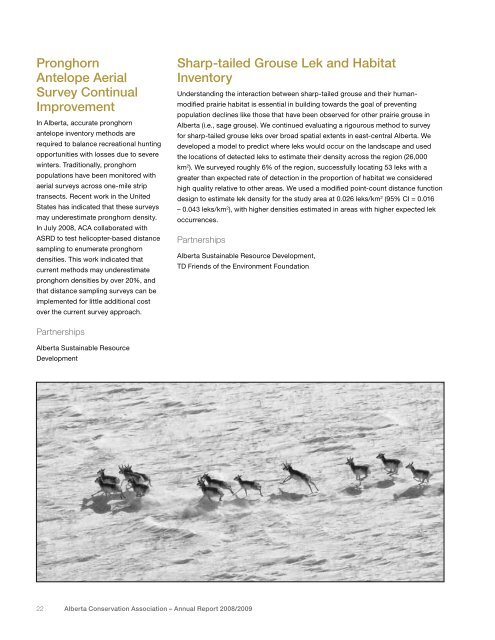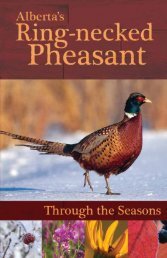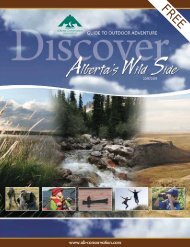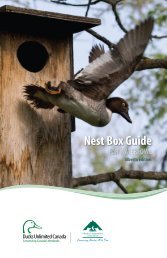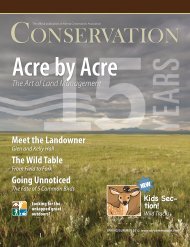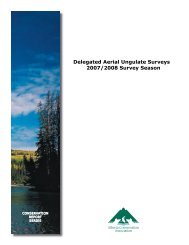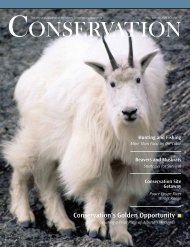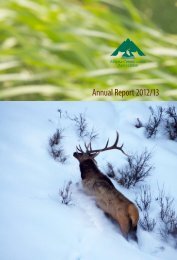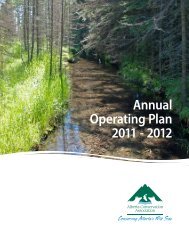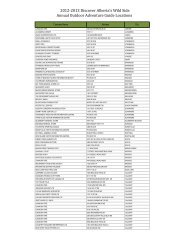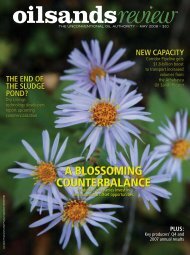Annual Report 2008/2009 - Alberta Conservation Association
Annual Report 2008/2009 - Alberta Conservation Association
Annual Report 2008/2009 - Alberta Conservation Association
Create successful ePaper yourself
Turn your PDF publications into a flip-book with our unique Google optimized e-Paper software.
Pronghorn<br />
Antelope Aerial<br />
Survey Continual<br />
Improvement<br />
In <strong>Alberta</strong>, accurate pronghorn<br />
antelope inventory methods are<br />
required to balance recreational hunting<br />
opportunities with losses due to severe<br />
winters. Traditionally, pronghorn<br />
populations have been monitored with<br />
aerial surveys across one-mile strip<br />
transects. Recent work in the United<br />
States has indicated that these surveys<br />
may underestimate pronghorn density.<br />
In July <strong>2008</strong>, ACA collaborated with<br />
ASRD to test helicopter-based distance<br />
sampling to enumerate pronghorn<br />
densities. This work indicated that<br />
current methods may underestimate<br />
pronghorn densities by over 20%, and<br />
that distance sampling surveys can be<br />
implemented for little additional cost<br />
over the current survey approach.<br />
Sharp-tailed Grouse Lek and Habitat<br />
Inventory<br />
Understanding the interaction between sharp-tailed grouse and their humanmodified<br />
prairie habitat is essential in building towards the goal of preventing<br />
population declines like those that have been observed for other prairie grouse in<br />
<strong>Alberta</strong> (i.e., sage grouse). We continued evaluating a rigourous method to survey<br />
for sharp-tailed grouse leks over broad spatial extents in east-central <strong>Alberta</strong>. We<br />
developed a model to predict where leks would occur on the landscape and used<br />
the locations of detected leks to estimate their density across the region (26,000<br />
km 2 ). We surveyed roughly 6% of the region, successfully locating 53 leks with a<br />
greater than expected rate of detection in the proportion of habitat we considered<br />
high quality relative to other areas. We used a modified point-count distance function<br />
design to estimate lek density for the study area at 0.026 leks/km 2 (95% CI = 0.016<br />
– 0.043 leks/km 2 ), with higher densities estimated in areas with higher expected lek<br />
occurrences.<br />
Partnerships<br />
<strong>Alberta</strong> Sustainable Resource Development,<br />
TD Friends of the Environment Foundation<br />
Partnerships<br />
<strong>Alberta</strong> Sustainable Resource<br />
Development<br />
22 <strong>Alberta</strong> <strong>Conservation</strong> <strong>Association</strong> – <strong>Annual</strong> <strong>Report</strong> <strong>2008</strong>/<strong>2009</strong>


